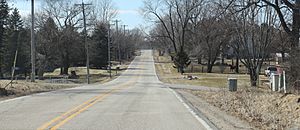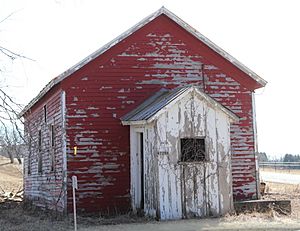German Corners, Wisconsin facts for kids
Quick facts for kids
German Corners, Wisconsin
|
|
|---|---|

Looking west at German Corners
|
|
| Country | |
| State | |
| County | Sheboygan |
| Elevation | 347 m (1,138 ft) |
| Time zone | UTC-6 (Central (CST)) |
| • Summer (DST) | UTC-5 (CDT) |
| Area code(s) | 920 |
| GNIS feature ID | 1565478 |
German Corners is a small, quiet place located in the state of Wisconsin, in the United States. It's not a city or a town with its own government. Instead, it's known as an unincorporated community. This means it's a group of homes and perhaps a few buildings that are part of a larger area, like a town or county, but don't have their own separate local government.
German Corners is found within the town of Greenbush. This area is part of Sheboygan County. It's a peaceful spot, often surrounded by farms and natural beauty.
Contents
What is an Unincorporated Community?
An unincorporated community is a place where people live close together, but it doesn't have its own official city or village government. Instead, the local services, like roads and police, are usually managed by the larger county or town it's located in.
How Communities Get Their Names
Many places in the United States, especially in states like Wisconsin, were named by the early settlers who moved there. Often, these names reflected where the settlers came from.
The "German" in German Corners
The name "German Corners" likely comes from the many German immigrants who settled in Wisconsin during the 1800s. They came to America looking for new opportunities and often formed communities where they could speak their language and keep their traditions. These communities often became known by names that reflected their heritage, like "German Corners."
Life in German Corners
Life in German Corners is typical of many small, rural communities in Wisconsin. It's a place where neighbors often know each other well. The area is known for its quiet, country setting.
Local Landmarks and History
Small communities like German Corners often have a few important buildings that tell their story. The old schoolhouse, for example, would have been a central place for children to learn and for the community to gather. These buildings help us understand the history of the people who lived there.




